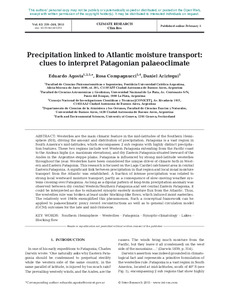Por favor, use este identificador para citar o enlazar este ítem:
https://repositorio.uca.edu.ar/handle/123456789/5455| Título: | Precipitation linked to Atlantic moisture transport : clues to interpret patagonian palaeoclimate | Autor: | Agosta, Eduardo Andrés Compagnucci, Rosa Aristegui, Daniel |
Palabras clave: | HEMISFERIO SUR; VIENTO; LAGOS; CLIMATOLOGIA; PRECIPITACIONES | Fecha de publicación: | 2015 | Editorial: | Inter-Research Science Center | Cita: | Agosta, E., Compagnucci, R., Ariztegui, D. Precipitation linked to Atlantic moisture transport : clues to interpret patagonian palaeoclimate [en línea]. Climate research 62, 2015. Disponible en: https://repositorio.uca.edu.ar/handle/123456789/5455 | Resumen: | Abstract: Westerlies are the main climatic feature in the mid-latitudes of the Southern Hemisphere (SH), driving the amount and distribution of precipitation. Patagonia is a vast region in South America’s mid-latitudes, which encompasses 2 sub regions with highly distinct precipitation features. These two regions include wet Western Patagonia extending from the Pacific coast to the Andean highs (i.e. maximum elevations), and dry Eastern Patagonia situated leeward of the Andes in the Argentine steppe plains. Patagonia is influenced by strong mid-latitude westerlies throughout the year. Westerlies have been considered the unique driver of climate both in Western and Eastern Pata gonia. This research is focused on the Lago Cardiel catchment area in central Eastern Patagonia. A significant link between precipitation in that region and local zonal moisture transport from the Atlantic was established. A fraction of intense precipitation was related to strong local westward moisture transport, partly as a consequence of slow-moving weather systems crossing over Patagonia. As long as a dipolar pattern of long-term precipitation anomaly was observed between dry central Western/Southern Patagonia and wet central Eastern Patagonia, it could be interpreted as due to enhanced synoptic easterly moisture flux from the Atlantic. Thus, the westerlies rule was broken at least under blocking-like flows, which induced moist easterlies. The relatively wet 1940s exemplified this phenomenon. Such a conceptual framework can be applied to palaeoclimatic proxy record reconstructions as well as to general circulation model (GCM) outcomes for the late and mid-Holocene | Cobertura Espacial: | PATAGONIA ARGENTINA |
URI: | https://repositorio.uca.edu.ar/handle/123456789/5455 | ISSN: | 1616-1572 | Disciplina: | INGENIERIA AMBIENTAL | Derechos: | Acceso Abierto | Fuente: | Climate Research Vol. 62, 2015 ISSN 1616-1572 |
| Aparece en las colecciones: | Artículos |
Ficheros en este ítem:
| Fichero | Descripción | Tamaño | Formato | |
|---|---|---|---|---|
| precipitation-linked.pdf | 5,3 MB | Adobe PDF |  Visualizar/Abrir |
Visualizaciones de página(s)
113
comprobado en 27-abr-2024
Descarga(s)
85
comprobado en 27-abr-2024
Google ScholarTM
Ver en Google Scholar
Este ítem está sujeto a una Licencia Creative Commons

